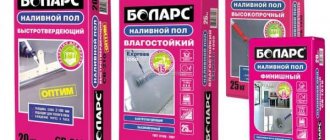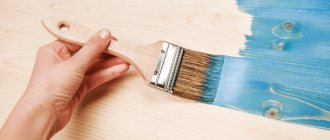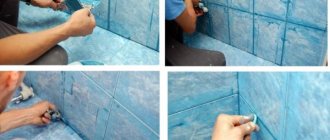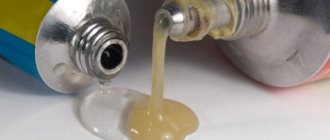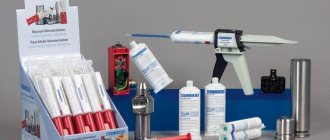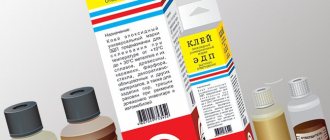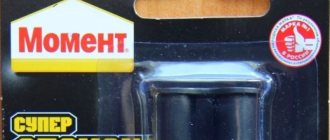Epoxy resin-based adhesive has long been recognized as a universal composition for household and industrial use. But when one of my friends decided to make jewelry based on epoxy, one of the first questions was, of course, how long it takes for epoxy glue to dry. Having enlightened her on this issue, at the same time I told her how to paint the resin in different colors, and also why sometimes it does not harden, and what can be done in this case.
Source fetasa.es
About material properties useful for design
The main component of epoxy glue is epoxy resin, a synthetic substance similar to polymers, liquid in its normal state, but hardening in the presence of catalysts (hardeners). The glue easily joins a variety of materials, forming a strong connection. In addition to resin, it contains components such as a solvent (for example, acetone) and plasticizers.
Epoxy is popular due to its successful combination of qualities: availability, strength, wear resistance; Moreover, during curing, its shrinkage is minimal. In liquid form, the composite composition has a different color, it can be transparent, yellow-orange (honey), wine-red, brown. The variety depends on the brand (composition) and manufacturer.
Designers value epoxy for its reliable bonding of any materials: from granite and bamboo to marble and wood. From a design point of view, the most interesting is the transparent type of glue, which allows for tinting; Epoxy resin can be easily painted in the desired shade, so it can easily fit into the interior of any style.
Source avenir-pro.com
There are areas of optical distortion in the resin
Possible reasons and tips
There are foreign inclusions in the coating or on the surface. The wrong abrasive was used
The container and mixing tool must be clean. Avoid using containers with traces of fat.
The surface must be carefully prepared. To sand epoxy resin, use #80 grit sandpaper.
The surface must be clean from all types of contaminants, oils, fats and water. To remove dust from the surface, you can use a clean cloth soaked in isopropyl alcohol or clean water. Do not use acetone or dirty rags for these purposes.
The coating must be applied within a few hours. After wet sanding and rinsing with water, it should not roll into beads - this indicates contamination of the surface. Wipe with a suitable solvent and rinse again with water until they disappear.
Types of compositions and features of working with them
Manufacturers offer composite adhesive in two forms:
- One-component . The hardener is added to the mixture at the production stage, so it is ready for use. Hardening begins immediately after opening the package, so you need to act quickly. Because of this feature, one-component material is not suitable for large-scale work, but it has proven itself well in sealing seams, as well as in the field of minor repairs.
- Two-component (EDP) . You purchase a set of two containers, with a composite composition and a hardener. The two-component composition is convenient in that it can be mixed in portions, obtaining material for performing large-scale work.
Two-component resin is more difficult to work with. The components are connected immediately before work, and it is important to observe the proportions (they are indicated in the instructions). When you mix the compositions, a polymerization reaction occurs, the mixture becomes solid and resistant to mechanical and chemical influences.
Source pinimg.com
After curing, the material becomes non-toxic and completely safe. But during the reaction itself, substances are released that can hardly be called beneficial to health: phenols and formaldehydes. The working mixture is dangerous throughout the entire process, from reaction to complete polymerization.
Therefore, you must wear a respirator, disposable gloves and long sleeves, especially if a large volume of pouring is expected. If suddenly the pendant caused an allergic reaction, then it was caused by other substances, for example, a decorative coating.
In order for work with epoxy glue to be successful, it is necessary to prepare the surfaces intended for gluing. They are cleaned of dust, dried and degreased. The ratio of EAF components can vary, but usually take 1 part hardener to 10 parts resin.
The putty composition (resin + mixture 407 or 410) flows and does not sand well
Possible reasons and tips
The putty is not thick enough.
Add more filler to the putty until it reaches the consistency of coconut oil. The more filler added, the thicker and easier it will be to sand.
Before filling vertical surfaces, allow the bottom layer to cure.
Note by S.B. From examining the branded MSDS, it appears that “filler #407” consists of a mixture of phenolic microspheres, perlite and aerosil, and “filler #410” is “a mixture of thermoplastic and inorganic microspheres.”
What determines the consumption and curing time?
If it is necessary to glue any materials, the consumption will depend on two factors:
- Thickness of the adhesive layer. If you apply the mixture with a standard thickness of 1 mm, then the consumption will be 1 liter (or 1.1 kg) per square meter.
Source prom.st
- Base material. If you need to glue porous materials (for example, wood, concrete), the consumption will be increased.
The answer to the question of how long it takes for epoxy resin to harden depends on two reasons: the brand of glue and the air temperature. For all compositions, the optimal operating temperature is from +10 to +30°C; It is better to avoid working at lower (especially negative) temperatures.
On average, liquid two-component EDP adhesives require about two hours for initial curing; It will take a day for complete polymerization. Specialized mixtures (cold welding) used for metal surfaces harden in 10-20 minutes.
Paint or varnish will not stick to the resin
Possible reasons and tips
The resin has not completely polymerized.
Allow the last layer of resin to cure well. If the weather is cool and the hardener is slow, wait a few days. In the form of a thin film, the polymerization time is another 1.3 times longer. As the temperature rises, the situation is reversed.
The paint is not compatible with epoxy resin.
Try a different paint. Some types of paints and hardeners are incompatible with each other. If you are not sure, do a test on a scrap piece of material.
Use hardener No. 207. It suits most paints and varnishes.
The resin surface is poorly prepared.
Before applying varnishes and paints, remove the amine film and sand the surface well.
Is it possible to use stain when coating with epoxy resin?
Water-soluble urethane stains are suitable for coating with epoxy resins. Be sure to make sure it is completely dry before applying the resin.
About curing methods
The question of how long it takes for epoxy to dry may become less pressing if you know how you can speed up the process. There is a so-called recommended curing temperature; judging by this criterion, epoxy mixtures can be divided into three groups:
- The polymerization process occurs without heating. Most EAF mixtures are for household use. At +20°C it may take 2-3 days for the structure to form. The process can be accelerated by heat treatment.
Source teplogalaxy.ru
- Polymerization requires a temperature in the range from +60 to +120°C. The composition is particularly resistant to organic solvents.
- Hot curing compositions, from +140 to +300°C. They are not used for household purposes, they are characterized by heat resistance and special (even by epoxy standards) strength.
If the epoxy doesn't cure
The resin is in no hurry to harden in due time for the following reasons:
- Most likely the proportion is off. If you do not measure enough hardener, the curing time increases to infinity (that is, the mixture will not harden). By the way, if the portion of hardener was too generous, the drying time of the epoxy resin can become fast, even abrupt, even foaming; There is no need to talk about quality here either.
- Perhaps the room is too cold and the reaction rate has slowed down. We'll have to wait longer.
- Technological errors. You may have not mixed the resin well, or applied it too thickly.
- The adhesive components are defective or expired; the storage conditions may have been violated. This may be indicated by the appearance of an unusual milky-white color when mixing the resin with the hardener.
Source files.ub.ua
You can solve the problem in the following ways:
- If the proportions are not correct, you will most likely have to remove the resin, prepare a new portion and refill it. You can try to add a little hardener to the finished layer, but such an undertaking does not always end well.
- To speed up a chemical reaction in a cold room, you can heat the surface, for example, with a gas burner. At the same time, you should not hold it in one place for too long so that the material does not boil. The boiled area must be removed.
- The proportion of 1 to 10 is not always correct. Check the packaging - it may indicate a different ratio. To ensure high-quality mixing, it is recommended to continue it intensively, for at least 2 minutes.
The adhesive joint is destroyed
Possible reasons and tips
Short curing time
The seam is depleted of resin: the resin has been absorbed into the porous surface, creating voids in the seam.
Apply a layer of resin to the surfaces to be bonded, followed by resin and filler. Very porous and end surfaces should be coated twice.
The bonded surfaces are dirty.
The surfaces to be bonded must be clean and sanded. After processing with carpentry tools, the wood surfaces must be sanded.
The connection area is insufficient for workloads.
Increase the area by forming fillets, gluing fasteners and forming miter joints.
Excessive compression with clamps squeezed the resin out of the seam.
You need to compress the parts just enough so that the resin is slightly squeezed out of the joint.
Epoxy: creativity and tinting
Epoxy resin has found widespread use in design. It is used to make three-dimensional paintings, jewelry, and interior decor. The transparent and multi-colored polymer has become a favorite potting compound for countertops.
Source design-homes.ru
They have long and successfully learned to paint the composition in different colors, create gradient transitions, as well as various effects (for example, radiance or iridescence). Ready-made dyes (usually acrylic) for epoxy can be found in craft stores. It’s easy to choose any option: transparent colored, matte, pearlescent paint, with glitter or metallic effect.
If you don’t have the right store nearby, the problem of how to paint epoxy can be quickly solved using improvised means. The main principle of selection is that the dye must not be water-based, and it is first mixed with the resin, and only then the hardener is added. You can experiment with the following materials:
- Ballpoint ink is better than gel, it is brighter and retains color better.
- Paints from an art store: oil, stained glass; ink for polymer clay. Nitro paints for cars. Alkyd dyes.
- Dry pigments from a hardware store.
- Alcohol solutions: pharmaceutical green, stain, printer toner.
Source ethnoboho.ru
What to do if the resin does not harden in the following video:
How to thicken epoxy resin?
Pyrogenic silica, better known as aerosil or pyrogenic silica, is an inexpensive filler for epoxy resin
resins, which allows you
to thicken
the working composition and give it viscosity, which may be required when working on vertical surfaces and in other cases where it is necessary to prevent ...
Interesting materials:
What to do if the monitor screen goes blank? What to do if the monitor goes off? What to do if the hydrangea begins to fade? What to do if Google doesn’t work but there is Internet? What to do if Google says your connection is not secure? What should I do if I can’t log into my Instagram? What should I do if I removed the video card? What to do if the screen brightness does not change on your iPhone? What to do if games do not run on Windows 7? What to do if Instagram does not log into your account?
Briefly about the main thing
Areas of application of epoxy resins – industry, construction, repair; Increasingly, they are used to make a variety of designer items, from jewelry to paintings and tabletops. There are one- and two-component types of compositions.
Working with two-component epoxy requires care and skill. If you violate the proportions, you will get a slowly hardening composition, and it is not possible to correct the situation in all cases. The curing speed depends on the air temperature in the room and the brand of glue; the process can be accelerated by heating the glued area.
Question
Write in the comments what you think - should you use chalk or activated carbon to get white or black epoxy resin?
